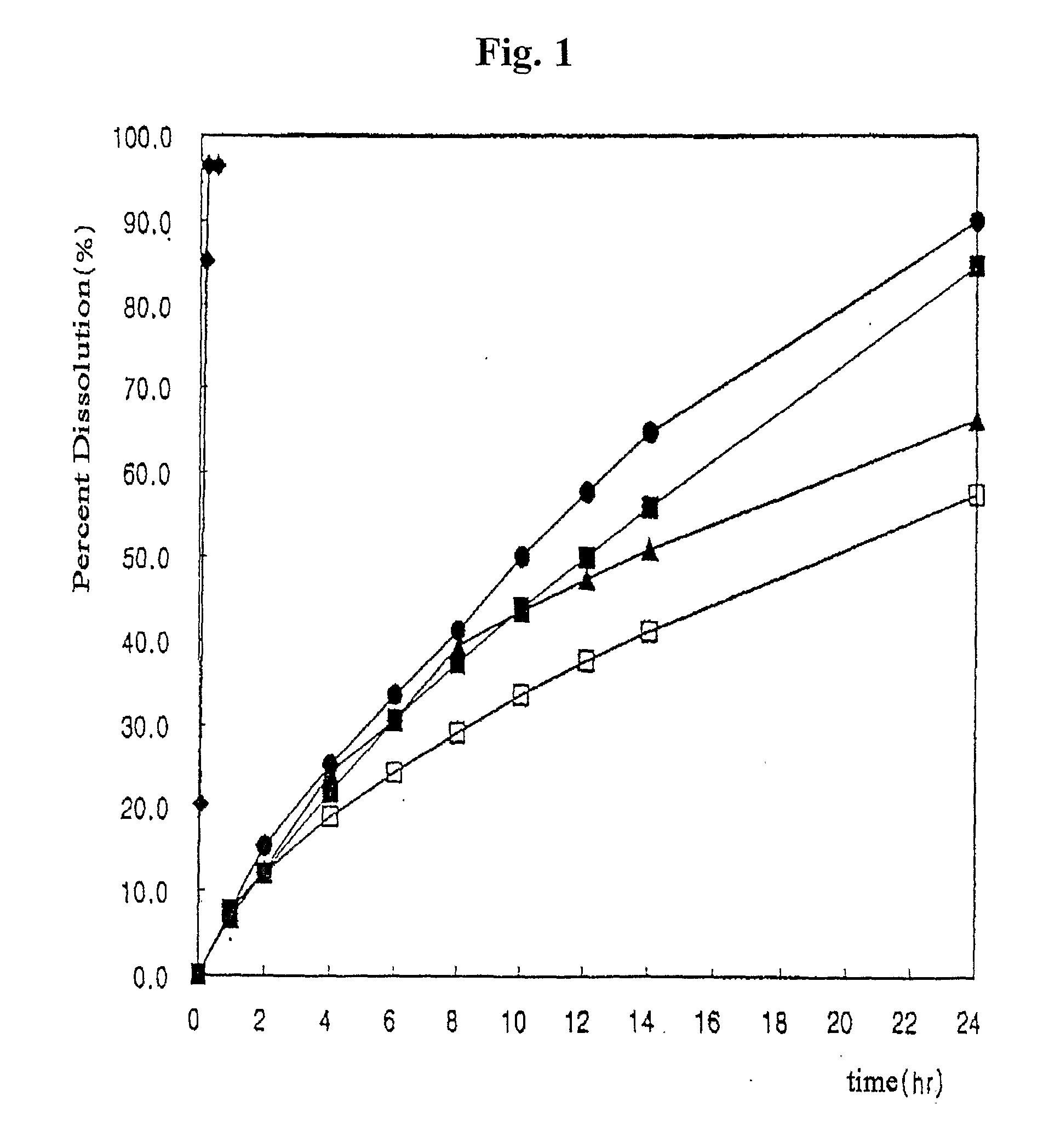Sustained-Release Preparations Containing Topiramate and the Producing Method Thereof
a technology of topiramate and preparation, which is applied in the direction of microcapsules, nervous disorders, drug compositions, etc., can solve the problems of patients' inconvenience, adverse side effects, and the inconvenience of patients' weight increases, so as to facilitate the control of drug release, improve the wettability of poorly water-soluble drugs, and reduce the total weight of drug preparations
- Summary
- Abstract
- Description
- Claims
- Application Information
AI Technical Summary
Benefits of technology
Problems solved by technology
Method used
Image
Examples
examples 1 to 3
Production of Matrix Tablets Containing Topiramate
[0046] Glyceryl behenate and topiramate were mixed under heating to 70° C. until the glyceryl behenate was melted or softened. The mixture was cooled to room temperature to form a solid lump. Thereafter, the solid lump was pulverized and passed through a 20-mesh sieve. The particles passed through the sieve were mixed with the additives shown in Table 1, and each of the mixtures was subjected to wet granulation (second granulation). The obtained granules were dried, and then magnesium stearate was added thereto. The mixtures were compressed into respective tablets. The matrix tablets had the respective compositions shown in Table 1.
experimental example 1
Surface Attachment Test
[0050] Solid dispersions were prepared from the tablets produced in Example 1 and Comparative Example 2 using solid dispersants having the same amount in accordance with the same procedure. Since the solid dispersion prepared from the tablet of Example 1 could block surface attachment of the primary granules by the second granulation, no attachment to the surface of a tablet punch or a die was observed upon compression. The granules produced in Comparative Example 2 showed severe surface attachment despite the addition of a lubricant, and as a result, the production of a tablet was impossible.
experimental example 2
Dissolution Test
[0051] Release profiles of the matrix tablets produced in Examples 1 to 3 and Comparative Example 3 and release profiles of the preparation of Comparative Example 1 were observed using a USP dissolution tester. The percent dissolution of the drug from the tablets was measured was measured as function of time under the following condition: pH 6.8, phosphate buffer, Paddle method, 50 rpm / 900 ml. The results as shown in Table 2.
TABLE 2Percent dissolution (%) with the passage of timeTimeExam-Exam-Exam-ComparativeTimeComparative(hr)ple 1ple 2ple 3Example 3(min.)Example 100.00.00.00.00.00.017.611.66.738.47520.3212.216.212.354.571085.3418.922.921.874.091596.5624.328.330.684.143096.4829.133.637.488.02——1033.437.443.7———1237.541.550.1———1441.145.155.9———2457.561.584.5———
[0052] Results of the dissolution test on the tablets of Comparative Example 1 and Examples 1 to 3 indicate that the drug was slowly released for 24 hours or longer by the double granulation. From the resul...
PUM
| Property | Measurement | Unit |
|---|---|---|
| weight | aaaaa | aaaaa |
| melting point | aaaaa | aaaaa |
| melting point | aaaaa | aaaaa |
Abstract
Description
Claims
Application Information
 Login to View More
Login to View More - R&D
- Intellectual Property
- Life Sciences
- Materials
- Tech Scout
- Unparalleled Data Quality
- Higher Quality Content
- 60% Fewer Hallucinations
Browse by: Latest US Patents, China's latest patents, Technical Efficacy Thesaurus, Application Domain, Technology Topic, Popular Technical Reports.
© 2025 PatSnap. All rights reserved.Legal|Privacy policy|Modern Slavery Act Transparency Statement|Sitemap|About US| Contact US: help@patsnap.com

